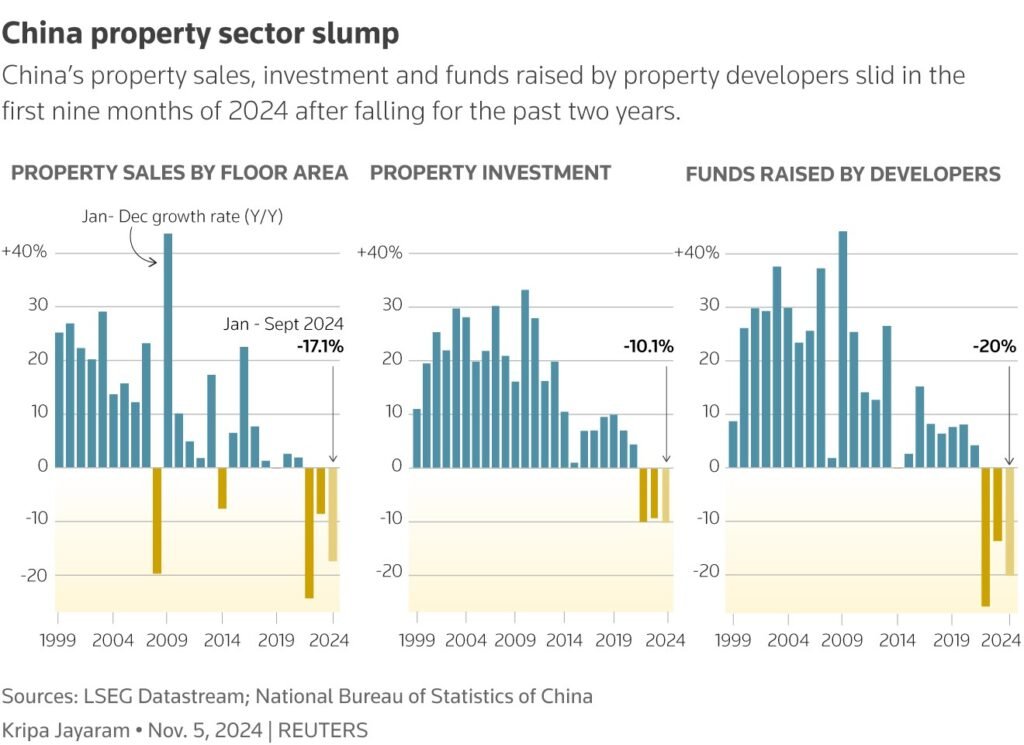China’s President Xi Jinping emerged from the G-20 and APEC summits with a consistent message: global stability and free trade are essential for shared prosperity. However, his agenda to bolster China’s slowing economy was overshadowed by escalating geopolitical tensions, including Donald Trump’s renewed tariff threats and Vladimir Putin’s provocative nuclear rhetoric.
China’s Economy Under Pressure
China’s economy, the second-largest globally, is navigating multiple crises. GDP growth has slowed to 5.2% in 2023, down from a robust 8.1% in 2021. A prolonged real estate slump, which accounts for nearly 30% of the country’s economic activity, has depressed household wealth and consumer confidence.

Meanwhile, deflationary pressures—evidenced by a 0.3% decline in the consumer price index in the third quarter of 2024—highlight weakening domestic demand.

Traditionally a backbone of China’s growth, exports have provided a rare bright spot. In the first nine months of 2024, Chinese exports grew 11.8% year-on-year, their fastest pace since 2021, driven by increased demand for electronics and electric vehicles.

However, Trump’s proposal to impose 60% tariffs on Chinese goods threatens this lifeline. According to the Peterson Institute for International Economics, such tariffs could reduce China’s annual GDP growth by 0.8 percentage points, exacerbating economic challenges and potentially triggering a chain reaction of protectionism globally.
Western Skepticism at the Summits
Xi’s diplomatic engagements in South America underscored the growing divide between Beijing and its Western counterparts. German Chancellor Olaf Scholz pressed for a resolution to the EU’s 10% tariff on Chinese electric vehicles, which European officials argue benefit from state subsidies that distort competition. France’s Emmanuel Macron called on Xi to play a more decisive role in de-escalating the war in Ukraine, emphasizing Europe’s unease with Beijing’s neutrality.
In contrast, UK Prime Minister Keir Starmer confronted Xi on human rights abuses in Xinjiang and Hong Kong, highlighting the trial of pro-democracy activist Jimmy Lai. Starmer’s remarks, met with immediate censorship by Chinese officials, reflected a broader mistrust of China’s intentions among Western democracies.
The contrast was stark: while Xi called for “mutual respect and peaceful coexistence,” leaders like Australia’s Anthony Albanese reaffirmed alliances with the U.S., emphasizing a commitment to countering Beijing’s regional ambitions.
Geopolitical Strains: Russia and North Korea
The war in Ukraine remained a persistent undercurrent during the summits, complicating Xi’s attempts to project China as a stabilizing force. Putin’s recent amendment to Russia’s nuclear doctrine, removing safeguards on first-use policies, has unnerved global markets and policymakers. Meanwhile, reports of North Korean troop deployments to assist Russia’s military efforts have placed additional pressure on Beijing, a key ally of Pyongyang.
While Xi avoided direct criticism of Moscow, his acknowledgment to South Korean President Yoon Suk Yeol that “a lot has changed” in the region signaled growing unease. China’s trade with Russia surged to a record $170 billion in 2023, up 35% from the previous year, reflecting deepening economic ties. However, Beijing risks alienating European partners critical to its export markets if it appears complicit in Russia’s actions.
Latin America: A Diplomatic Bright Spot
In South America, Xi found a more receptive audience. In Peru, he inaugurated a $1.3 billion port expected to handle 1.5 million containers annually, strengthening China’s trade links in the region. In Mexico, Xi and President Claudia Sheinbaum discussed deepening economic cooperation, with bilateral trade already surpassing $110 billion in 2023. Even Argentina’s Javier Milei, a vocal critic of Beijing during his campaign, signaled openness to collaboration, marking a diplomatic win for China.

Brazil, China’s largest trading partner in Latin America, accounted for $170 billion in bilateral trade in 2023, a 10% increase year-on-year. Brazilian President Luiz Inácio Lula da Silva’s warm reception of Xi underscores China’s growing influence in emerging markets, which Beijing increasingly relies on to offset slowing trade with the U.S. and Europe.
Domestic Challenges and Policy Shifts
Domestically, Xi faces mounting pressure to stimulate growth. Despite Finance Minister Lan Fo’an’s promise of “more forceful” fiscal policies in 2025, China’s reluctance to implement large-scale stimulus has frustrated investors. Goldman Sachs estimates that increased tariffs could compel Beijing to pivot toward bolstering domestic consumption, a strategy that has faced resistance due to its potential to disrupt China’s export-driven economic model.

China’s manufacturing sector, which accounts for 28% of GDP, remains a key focus. Beijing has invested $150 billion in green technology over the past year, seeking to dominate markets like electric vehicles and solar panels. However, trade barriers in Europe and North America threaten to stifle this growth.
Trump’s Return: A Wild Card
Trump’s return to the White House poses significant risks for China. During his first term, tariffs on Chinese goods cost the global economy $300 billion, according to the IMF. A second round of trade wars could further isolate China, forcing it to deepen ties with countries like Russia and Iran while seeking new opportunities in Africa and Latin America.

Chinese officials have hinted at a more flexible foreign policy under Trump, with Xi emphasizing “dialogue and cooperation” in his remarks. However, analysts caution that Beijing’s room to maneuver is limited, as Western powers increasingly align against China’s growing economic and geopolitical ambitions.
The Bigger Picture
Xi’s diplomatic push reflects a broader strategy to position China as a stabilizing force in an increasingly fragmented world. Yet, Trump’s protectionism and Putin’s unpredictability have left Beijing on the defensive, struggling to maintain its narrative of globalization and multilateralism.
While Xi’s engagements in Latin America highlight China’s ability to forge new alliances, the challenges at home and abroad remain daunting. With GDP growth slowing, geopolitical tensions rising, and trade relationships fraying, Xi’s vision of a stable, interconnected global economy faces significant obstacles.
The coming year will be critical for China as it navigates these challenges, balancing domestic reform with an increasingly volatile international environment. For now, Xi’s promise of “peaceful coexistence” and “mutual prosperity” remains aspirational, with the road ahead fraught with uncertainty.


